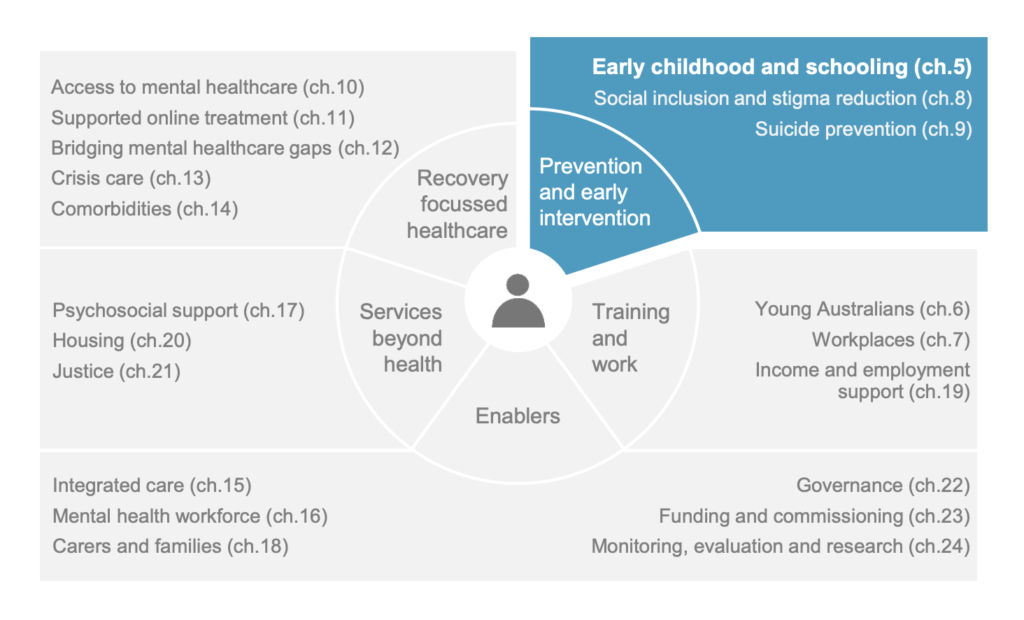Stepping up for Students: Australia Deepens Its Commitment to Improving Child Mental Health and Wellbeing in Schools
There has seen a groundswell of activity to strengthen the focus on child mental health and wellbeing in the education sector. Two national reports were published in the past 12 months that placed a clear vision and path forward for schools, teachers and students in relation to mental health and wellbeing.
This article provides an overview of the relevant sections of:
- Mental Health, a report released by the Productivity Commission (2020)
- The National Children’s Mental Health and Wellbeing Strategy, released by the Mental Health Commission (2021)
Both documents provide a range of recommendations and actions applicable to schools. These are largely consistent with the earlier National Review of Mental Health and Programmes and Services (2014), acknowledged at the end of this article.

Schools in The Productivity Commission’s Report “Mental Health”
The Productivity Commission released the final report of Mental Health to the public in November 2020. This 25 chapter, 1600+ page report outlines the case for reform and makes recommendations to federal and state governments that are required for improvement. Recommendations are applicable to workplaces, schools and universities, the justice system, community groups and services for healthcare, psychosocial support, and housing.
Chapter 5 is of most relevance to schools and the education system.

The actions in chapter 5 foreshadow a raft of changes that will be required at school level, including the collection of data, the development of policies and programs, the training of teachers and reporting against outcomes.
The actions include:
Action 5.3 – Wellbeing in the Education System
“Governments should develop a comprehensive set of policy responses to strengthen the ability of schools to assist students and deliver an effective social and emotional learning curriculum.”
Action 5.4 – Improving Teacher Skills Sets
“Ongoing learning on child social and emotional development and wellbeing should form part of professional development requirements for all teachers” (noting that the report states that this should start later, after regulatory authorities have had the opportunity to accredit teacher education programs and professional development programs).
Action 5.5 – Accrediting Social and Emotional Programs in Schools
“Social and emotional wellbeing programs delivered in schools should be based on rigorous evidence and have the ability to demonstrate improvement in student wellbeing outcomes.
Action 5.6 – Wellbeing Strategies in Schools
“All schools should be required to report on their progress against wellbeing outcomes, as set out by in an updated National School Reform Agreement (Action 5.3). In addition to outcomes, all schools should report to regulators on their dedicated strategies, including leadership and accountability structures, to deliver wellbeing outcomes for students and teachers. Each school principal should be accountable for the development and monitoring of wellbeing strategies, and progress against national targets.”
Action 5.7 – Data on Child Social and Emotional Wellbeing
“Governments should expand the collection of data on child social and emotional wellbeing, and ensure data is consistently used in policy development and evaluation.”

Schools in The National Children’s Mental Health and Wellbeing Strategy
Many of the ideas of the Productivity Commission’s report are given fuller consideration in the National Children’s Mental Health and Wellbeing Strategy. Published in October 2021 by the Mental Health Commission, the full Strategy outlines four major areas, or which “Education Settings” are the third. This definition includes primary schools and early childhood learning servies.

In publishing the strategy, the Mental Health Commission recognises that the education system, including schools, is already doing a considerable amount to support the wellbeing of children. The intent is to strengthen these existing efforts and support educators in the important role they play in promoting child mental health and wellbeing.
This third section of the report acknowledges that the education and early childhood systems need to be based on frameworks and standards that support the mental health and wellbeing of children. For the three objectives, 17 actions are recommended. These objectives and actions are outlined below, using excerpts from the Strategy with some light edits.
Objective 3.1 – A wellbeing culture
Educational settings provide a unique and almost universal opportunity for promoting child mental health and wellbeing. It is imperative that all educational settings play their role in promoting mental health and wellbeing in their students.
Actions for A Wellbeing Culture
a. Conduct thorough reviews of school and early childhood policies and processes, looking for opportunities to reduce possible stigma and discrimination.
b. Identify senior staff within early childhood learning services to be responsible for (1) planning and coordinating wellbeing activities for the students, and (2) maintaining knowledge of and relationships with locally available and online supports.
c. Employ wellbeing coordinators in each primary school to be responsible for (1) planning and coordinating wellbeing activities for the students, and (2) maintaining knowledge of and relationships with locally available and online supports. These positions should be funded on an ongoing basis.
d. Identify opportunities to incorporate conversations about mental health and wellbeing into the school or early childhood daily routines, with the expectation that all staff and students have the opportunity to contribute to these discussions.
e. Promote evidence-based, locally available or online supports and services to children and families through schools and early childhood learning services.
f. Outline and regularly report on how schools and early childhood learning services are improving on current levels of cultural accessibility for children who identify as Aboriginal or Torres Strait Islander or from culturally and linguistically diverse backgrounds.
g. Implement evidence-based wellbeing programs within schools and early childhood learning services, with support from existing initiatives such as Be You.
h. Increase accessible activities after school and during school holidays to provide respite for parents and children.
Objective 3.2 – Targeted responses
All early childhood learning services and schools should have a wellbeing plan in place for their students, with policies and processes developed or adapted to address the gaps in support identified as part of wellbeing planning. This should be based on an audit of policies and processes to examine whether they are effective in delivering wellbeing outcomes for students.
Flexible funding must be available to schools and early childhood learning services for the purpose of improving policies and processes and ensuring high fidelity program implementation. This funding should be allocated based on need, with funds available specifically for quality improvement activities and for implementation of evidence-based psychosocial and therapeutic supports.
Actions for Targeted Responses
a. Require all early childhood learning services and primary schools to develop a comprehensive wellbeing plan, which should outline what the service or school will do to address issues identified as a priority for their students. Progress against these plans should be reported on regularly.
b. Make funds available for schools to implement quality improvement activities related to student mental health and wellbeing.
c. Make funds available for schools to deliver evidence-based programs targeting the needs identified as part of action 3.2.a, with a particular focus on bullying and racism.
d. Adapt existing resources and training programs to provide educators with the skills to discuss mental health concerns about a child/student with their parents or carers, including provision of interpreting services where necessary.
e. Establish and implement trauma-informed procedures for responding to students disengaging from education
Objective 3.3 Well-equipped educators
Educators are uniquely positioned to identify signs when children are struggling and to facilitate their connection with supports.
Actions for Well Equipped Educators
a. Develop professional learning courses/modules specifically designed for educators that focus on key mental health and wellbeing topics.
b. Create clear processes to guide educators when concerned about the mental health of a student/child, including up-todate information regarding the range of locally available or online support options for children and families (note role of wellbeing coordinators, see action 3.1.c).
c. Provide designated wellbeing coordinator staff (see action 3.1.c) with appropriate training to undertake their role.
d. Ensure formal, independent mental health and wellbeing supports are made available to all educators for their own mental health and wellbeing, building on existing teacher and principal wellbeing plans and frameworks.
e. Establish professional learning requirements for educators in relation to mental health, with paid protected time for participation.
A Continuation of the Direction for Schools from 2014?
In many ways, the 2020 report by the Productivity Commission and the National Children’s Mental Health Strategy of 2021 reiterates the direction of the National Review of Mental Health and Programmes and Services conducted some six years earlier.
This report, published in late 2014 and available here, intended to promote the wellbeing and mental health of the Australian Community, beginning with a healthy start to life. Many of the 31 recommendations are directly relevant to children and young people. This includes the recommendations to:
- strengthen school-based programs and the broader mental wellbeing agenda in schools, including resilience and targeted interventions in curricula and pedagogical frameworks;
- include evidence-based approaches to mental health and wellbeing in the training and continuing professional development of teachers and early childhood educators; and,
- expand measurement of wellbeing in the early years to middle childhood.
Other Related Documents
Of course, many of these latest ideas are consistent with existing good practice and professional guidelines, for example those for school psychologists in Australia.




